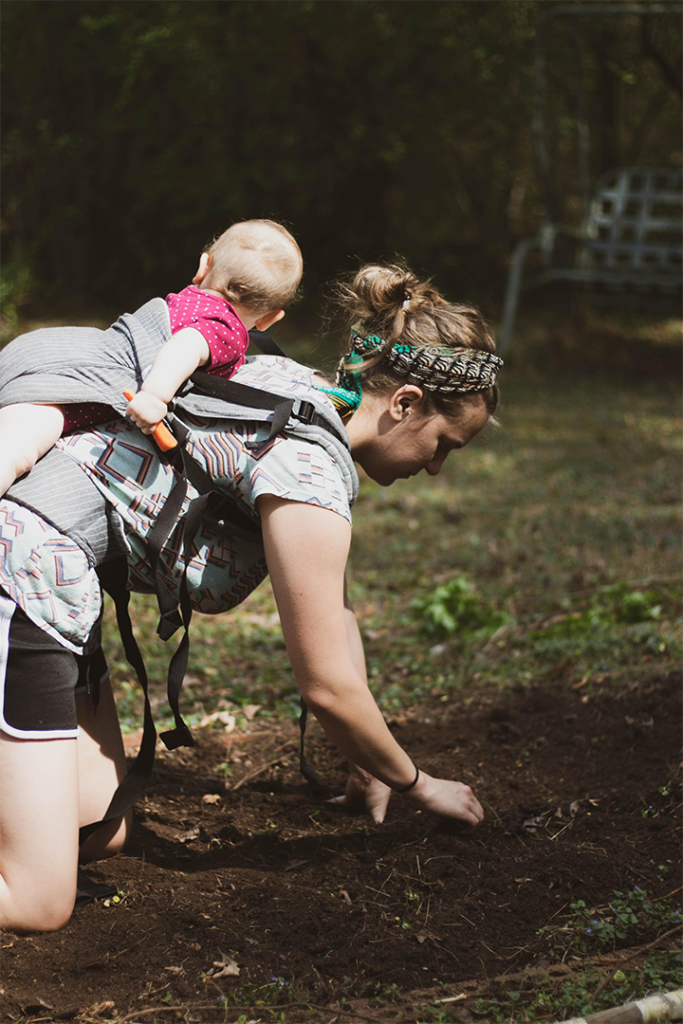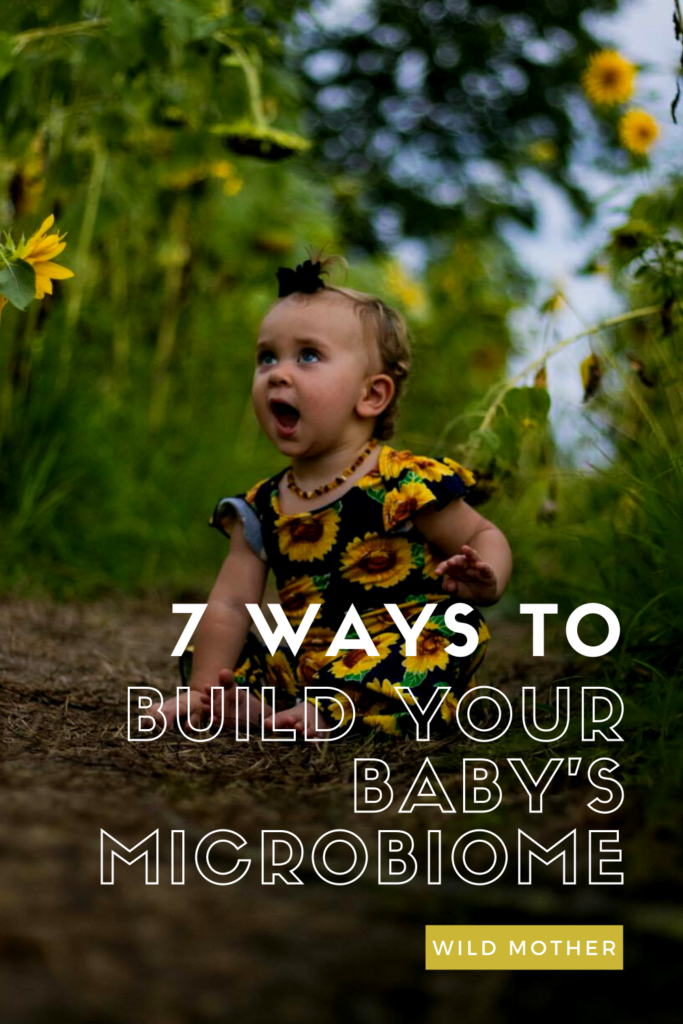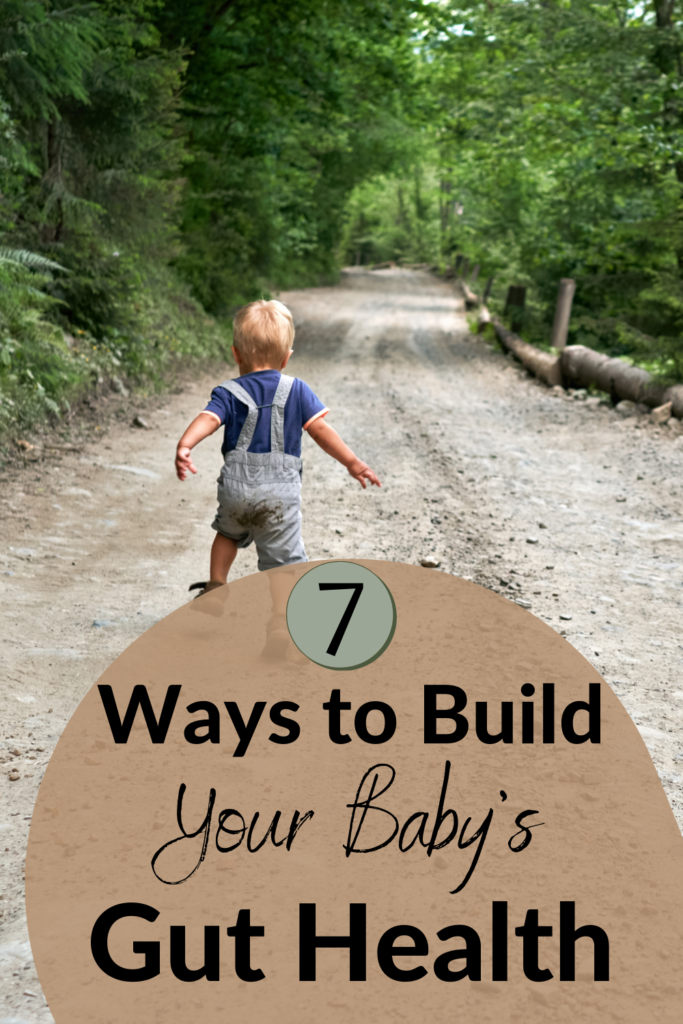What do you think of when you hear the phrase, “The microbiome”? Many of us may think of “gut health” or “bacteria” or maybe even “germs”, but I think relatively few people realize how crucial the microbiome is to overall health- including many medical professionals. In this article, I want to offer you seven tips to get started learning how to build your baby’s microbiome and gut health from the start.

It is my prediction that in 50 years, Western medicine is going to catch up to some of the science being done on the microbiome and how essential it is to health and realize that maybe they shouldn’t have been offering so many procedures and medications that can hurt the microbiome. Specifically to infants and children. Specifically during birth.
I’m not a microbiologist, or even a medical professional, therefore I do not feel qualified to go into depth about how the microbiome works and how having a microbiome that lacks diversity can really impact your life.
However, I do have a few resources I can recommend for you start doing your own research on it.
(I am an Amazon Affiliate and will receive a small commission if you choose to purchase a product through my link and this does not add any extra cost to you)
I picked up Let Them Eat Dirt at the library while pregnant with my first baby. It really educated me on the importance of microbiome health in infants and children, and what I could do to help establish that.
There are some parts of the book that I feel science has come to varied conclusions on (and I do not agree with the authors on), so as always please make sure you’re reading a variety of literature to educate yourself. Overall though, this book is well worth its cost and I learned so much through it.
The steps that I discuss below are also largely discussed in Let Them Eat Dirt, although all the words below are my own.

Seven Ways to Build Your Baby’s Microbiome
VAGINAL BIRTH
RELATED: What is a Primal Birth?
The vaginal canal (birth canal) has a unique microbiome that is rich in organisms that inhibit growth of pathogenic bacteria (including bacteria that cause preterm labor).
As the baby is passing through the birth canal, their entire body – including their eyes, mouth and nose- gets coated in this “good bacteria” from their mama.
Studies show that babies born vaginally have distinct differences in their microbiome compared to babies born via C-section. Babies that are born via C-section are more prone to developing immune issues like asthma and allergies, compared to babies who are born vaginally.
Having a vaginal birth is a great way to give your baby the very best start at life, however if an emergency does happen and you need to have a Cesarean, you still have options. On our birth plan, we listed that in the case of a C-section, we would like to have vaginal seeding done in order to give baby some of the benefits of my vaginal flora.
I recommend reading about vaginal seeding and talking to your midwife, but essentially it involves inserting a piece of gauze into the birth canal to transfer some of the vaginal microbiome to the gauze, then wiping the baby’s face, mouth, eyes, etc with the gauze.
This is not nearly as effective as having a vaginal birth, however, it does have benefits, and babies who were wiped in this way had a microbiome resembling closer to that of a vaginally born baby. It’s not perfect, but it’s a great alternative for starting to build your baby’s microbiome from the beginning when a vaginal birth is not possible.
References: This article
BREASTFEEDING
Not only does breastmilk protect infants from a number of infectious diseases, decrease their likelihood of developing and dying from pneumonia, and a host of other benefits, it ALSO directly builds your baby’s microbiome.
Breastfed babies have a more consistent and uniform microbiome compared to babies fed with formula. Even babies who are only given a small amount of formula, or formula only occasionally, have changes in their normal microbiota to resemble more closely that of completely formula fed babies.
This can have a lot of future implications, and it’s really important that parents are aware of these implications when debating on supplementing with formula.
It is also my opinion that science has yet to discover just how incredible a mother’s breastmilk is for her individual baby. Breastmilk is full of prebiotics that also help nourish and develop healthy oral and gut bacteria.
GROWING UP WITH PETS
Studies have shown that Amish children have an incredibly diverse microbiome compared to a lot of other children across the US.
Why is this?
Amish children live much closer to nature than most children – they spend a lot of their time outside playing and working on the farm, and are regularly working with animals.
It’s been shown that children who grow up around animals are going to have more varied bacteria then their pet-less peers. This study even showed that exposure to pets prenatally and in the first 3 months of life nearly doubled the abundance of Oscillospira and/or Ruminococcus.
I implemented this in a few ways when my daughter was just a few months old. I didn’t freak out if our dog licked my baby’s hands, and I would intentionally let her touch his fur and not run to immediately wash her hands. She would also lay on the ground where there was occasionally some dog hair (despite my best attempts to diligently vacuum…lab hair gets EVERYWHERE).
My dream is for my family to eventually be able to have some property and land where we can keep farm animals so my children can get exposure to different animals and help diversify their microbiome even more. If you have pets, you are naturally a few steps ahead in learning how to build your baby’s microbiome. Congrats!
LET THEM EAT DIRT
Okay, maybe not literally, but do let them play in dirt and don’t be scared if they get a little bit in their mouths. Let them help in the garden. Build a mud kitchen and let them mix dirt and water and make pretend food.
We have this stereotype in our culture that being “dirty” is bad, or that it’s gross to have dirt under our finger nails. This can transmit to our kids hearing that dirt is dirty, therefore dirt is bad. That’s the opposite of what we want!
I have identified all the weeds in my yard, so I know which ones are edible and which ones are not. When I am working in the garden, my baby is either on my back or on the ground playing in the dirt beside me. I let her taste different weeds, I let her taste the dirt, I let her snack on the kale or lettuce I’m growing, etc. I try to let her explore as un-unhindered as possible while still being safe.
I’m not afraid to let her get dirty. I do try to stop her from eating gobs of dirt, and obviously, I don’t let her eat rocks or bugs and bark and sticks, but overall I’m happy to let her explore because I know that by exploring she is diversifying her microbiome all on her own!
DON’T OVER SANITIZE
I’ll be the first to admit, I’m not a fan of germs that are in public places like grocery stores, public bathrooms, or restaurants.
I will always stop my baby from sucking on the grocery cart handle, and I will always wipe down and cover the high chair at restaurants before putting my baby in it. There are a lot of people in the world who do not take their health seriously and I’m not interested in their carelessness making my baby sick.
That being said, I really do try not to over sanitize. Germs hold an important place in our world, and I’m not interested in replacing the germs with toxic chemicals like Clorox or Bleach.
Typical Alcohol hand sanitizers kill all bacteria – they don’t differentiate between good, gut-healing bacteria and bad, toxic germ bacteria. They just kill it all.
I don’t use hand sanitizer on my baby’s hands, and I have cut down on using it on my hands as well. Whenever possible, we go to the bathroom and wash our hands – especially at restaurants when a bathroom is so easily accessible.
EAT DIVERSE FOODS
Food is medicine, and food also feeds or starves bacteria in your microbiome. So eat whole foods – eat lots of veggies – eat a wide variety of foods.
I know sometimes for me, it’s easy to eat the same vegetables over and over again because it’s what I’m familiar with and I know how to cook them. I’m trying to branch out and explore with foods that I’m not used to cooking: Grains like barley, couscous, and einkorn; vegetables like Yucca, eggplant, and arugula; and fruits like Papaya, Durian, and Lychees.
Eat as many diverse whole foods as you can to help expose your body to a wide variety of cultures and bacteria. I like shopping at Ethnic markets to try out different foods!
EAT FERMENTED FOODS
RELATED: How I switched my diet from Vegan to Nourishing Traditional Foods
It is estimated that 2 ounces of home fermented sauerkraut have more probiotics than a bottle of 100 count probiotic capsules. Our ancestors have been fermenting food for thousands of years.
Read what Dr. Zach Bush says about fermented foods like sauerkraut:
“The process of lactic acid fermentation used to transform salt and cabbage into sauerkraut increases food enzymes and vitamins, particularly vitamin B. Homemade wild sauerkraut is rich in beneficial bacteria – friendly microorganisms which help to colonize the gut, train the immune system, and manufacture vitamins in the digestive tract. Wild fermented foods have been exposed to the air and hundreds of species become integrated during the fermentation process. “
My baby absolutely loves Sauerkraut. It was one of the first foods I introduced to her around 6 or 7 months, so now she has such a taste for the flavor. We eat it every day!
Thanks for reading this article! Are you intentional about your microbiome health? I would love to hear any specific strategies you have in place to build it!


